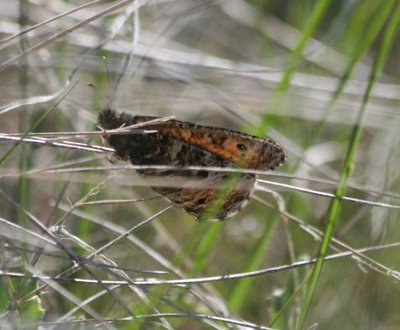 Eastern birders count the American bittern among the rarest of the rare, but in North Dakota it's possible to see them both standing in the reeds by the roadside and in flight.
Eastern birders count the American bittern among the rarest of the rare, but in North Dakota it's possible to see them both standing in the reeds by the roadside and in flight.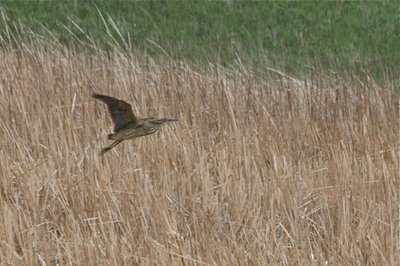 If you look closely at these photos you can see the bittern's impossibly long green toes sticking out behind its tail.
If you look closely at these photos you can see the bittern's impossibly long green toes sticking out behind its tail.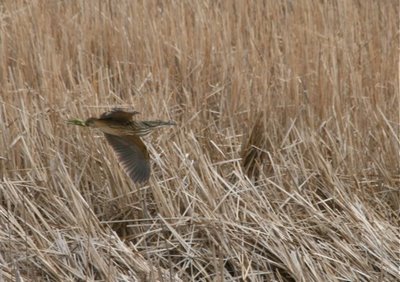 They're kind of Gollumesque birds. This one was being perforated by a red-winged blackbird as it made its way toward a slough.
They're kind of Gollumesque birds. This one was being perforated by a red-winged blackbird as it made its way toward a slough.Something you don't see very much in the East: a bull, walking down a country road toward a battery of birders.
 He was much more interested in some heifers penned in the grove, and turned off before I had to get out my red cape and tri-cornered hat. Tracks showed that he'd been wandering up and down the road for quite some time.
He was much more interested in some heifers penned in the grove, and turned off before I had to get out my red cape and tri-cornered hat. Tracks showed that he'd been wandering up and down the road for quite some time.Abandoned houses are increasingly rare where we live, thanks to people's propensity for simply knocking or burning them down. I love abandoned houses, love to poke around in them and look for signs of the lives they once sheltered. Bill of the Birds is very spooky but he ventured a peek in this one. He has his neck warmer pulled up as a kind of stovepipe hat; it was that cold. Oz never did give nothin' to the Tinman.
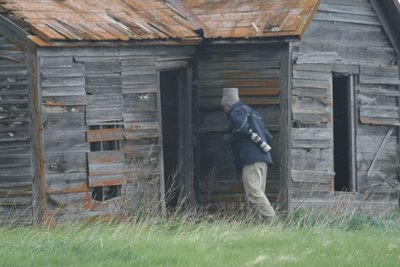
Outside was an old buckboard wagon. I wondered how long all this had stood on the prairie, covered by snow and battered by the incessant wind. It was freezing, even in June, on this drizzly day.
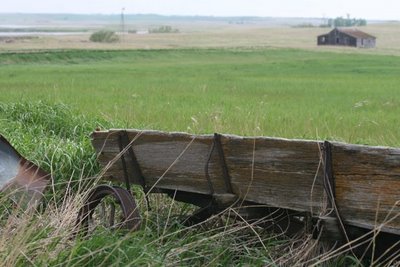 Abandoned buidings are everywhere out here, each one lonelier and more evocative than the last. This one might have been a schoolhouse, with sturdy little blonde kids inside.
Abandoned buidings are everywhere out here, each one lonelier and more evocative than the last. This one might have been a schoolhouse, with sturdy little blonde kids inside.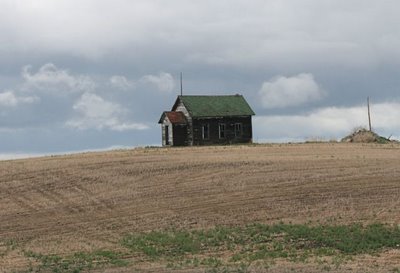 But the rarest of the rare came over the phone as we were birding our way back to Carrington after a long day in Kidder County. Three whooping cranes had been reported from a farm section that was about ten miles from nowhere. We swooped in and spotted them without any problem. It's hard to miss four-foot-high white birds on a muddy field.
But the rarest of the rare came over the phone as we were birding our way back to Carrington after a long day in Kidder County. Three whooping cranes had been reported from a farm section that was about ten miles from nowhere. We swooped in and spotted them without any problem. It's hard to miss four-foot-high white birds on a muddy field.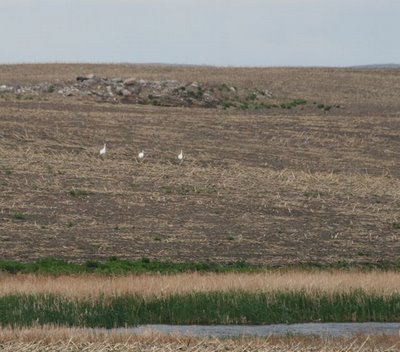 I am not proud of this photo, but we were almost a mile away, and even at that the cranes were nervous about us--walking away. We dared not press them. Because nothing goes unnoticed for long, even in the middle of nowhere, a truck soon rolled up. Inside was a landowner who had been watching over the birds for more than a week. He had been quiet about them, realizing that they were vanishingly rare and worthy of protection.
I am not proud of this photo, but we were almost a mile away, and even at that the cranes were nervous about us--walking away. We dared not press them. Because nothing goes unnoticed for long, even in the middle of nowhere, a truck soon rolled up. Inside was a landowner who had been watching over the birds for more than a week. He had been quiet about them, realizing that they were vanishingly rare and worthy of protection.It was nice to know they'd had a good week's rest, especially when a car with three clued-in birders appeared on the horizon and drove perhaps a half-mile over the prairie directly toward the birds. The birders got out, bristling with scopes and telephoto lenses, and put them to wing, apparently for good. We were too far away to hail them or to do anything more than shake our heads in bewilderment at the intrusion. It was especially embarrassing given that the landowner had been so gracious to us. The cranes weren't seen again. There were a lot of disappointed birders at the festival for whom whooping crane would have been a life bird.
Asking around with USFWS personnel and checking listservs soon revealed that the three birds were one-year-old males that were led south via an ultralight aircraft from their natal area in Wisconsin. According to Tom Stehn, Whooping Crane Coordinator at Aransas NWR, they returned to central Wisconsin this spring just as researchers had hoped, then (naughty birds) took off for North Dakota. These are the things that radios and color bands tell us. If there's a silver lining to this story, it's probably a good thing that the cranes, imprinted as they are on an ultralight aircraft, still retain such a healthy and well-founded suspicion of people. It's tough to be a tall, white bird that everyone wants a piece of. They're the Brangelinas of the bird world, and they don't like the paparazzi, either.






11 comments:
I like seeing abandoned old houses and such too Julie and can't help but stare and imagine the history there.
Whooping Cranes! Wow! How cool was that. Too bad the bird paparazzi was so disrespectful.
Is it wrong that I was equally excited about the Arctic as the Cranes? I think they're really cool butterflies. Tis a shame about the idiot birders spooking the cranes though.
Is that the first time America was quoted on your blog?
I wouldn't have called them clued-in birdwatchers. I would call them clueless birdwatchers.
I love the shots of the old houses. What a prairie life they have seen.
Whooping Cranes - wow. Reasonably spooked.
Abandoned houses amuse me and I love standing OUTSIDE of them wondering about the history and what lurks inside. Bill of the Birds and I share the same sentiment...
How marvelous to see Whooping Cranes ! More about the ultralight guided reintroduction project can be found at www.operationmigration.org. Each summer since 2001 at Necedah NWR in Wisconsin, a small number of Whooping Crane chicks have been trained to follow an ultralight aircraft and led to Florida in the autumn, thereafter the birds migrate on their own. Photos and ongoing reports about raising and training the chicks are at "In The Field" on the above web site. Daily reports about the autumn migration will be posted there too. The 2008 chicks are not yet old enough to fly and are very cute.
"Gollumesque". Perfect.
"My precioussssssss.....my birthday....presssssent....."
I hate it when bone-headed birders make the rest of us look bad.
Reminds me of the burrowing owl found near here recently. Over-zealous birders spooked it away. Imagine how exhausted that poor bird was, only to be driven off by humans. Dammit.
I'm still trying to get my head around freezing in the summer ...
Lots to like in this post ... the idea of being chilly, abandoned homesteads, rare birds ...
and a bit of America.
Nice.
Hey, thank you for the kindness and the encouragement back at PF.
Much appreciated.
Yes but I bet they have their babies much less obtrusively than Brangelina does (do?). Can you explain why it's a bad thing that the cranes left Wisconsin for North Dakota?
LOG, they're trying to establish a breeding flock in Wisconsin (eventually), and they'd like the birds to stay together during the breeding season there and start making whoopie. Three young males taking off for North Dakota in high breeding season takes those nice genes to a place where there's no chance of pairing off or making more whooping cranes (the ultimate goal). Anyone involved with the crane project who knows better may feel free to correct me, but I'm pretty sure they don't like to see their precious birds wander around willy-nilly. There are a lot of people out there who are curious and uninformed enough to shoot one, just to see what it is. And their numbers have been boosted at such tremendous effort.
Patrick, I have never before quoted America on my blog. You may be sure it is not the last time. Because on this blog, you can quote whomever you want, and there ain't no one for to give you no pain.
Aha.
I get the sense from what you're saying here that it felt good to be out with the cranes...
Sister, I do believe there's times when a whooper sure can be a friend of mine
Post a Comment